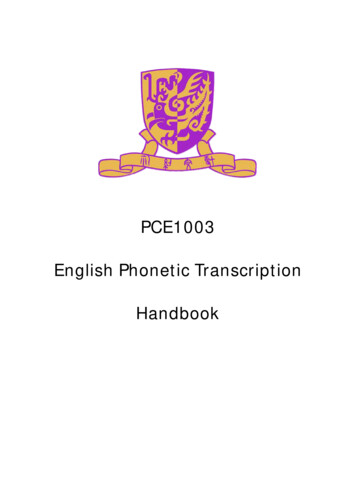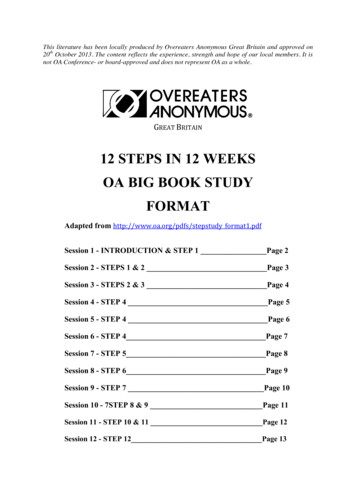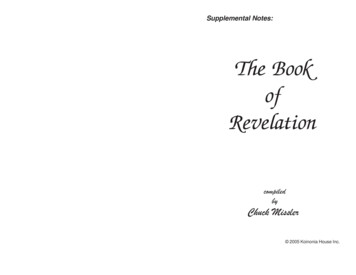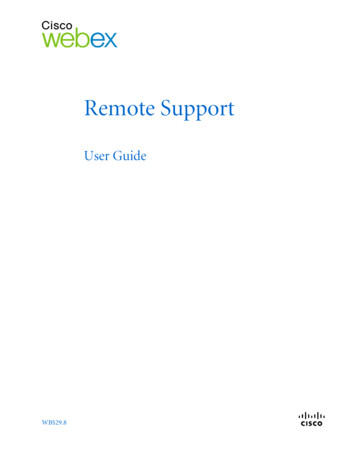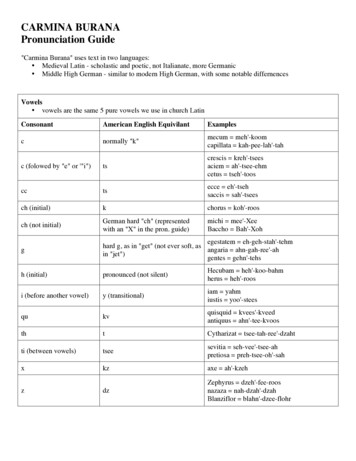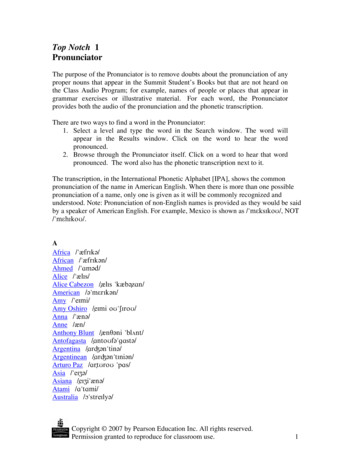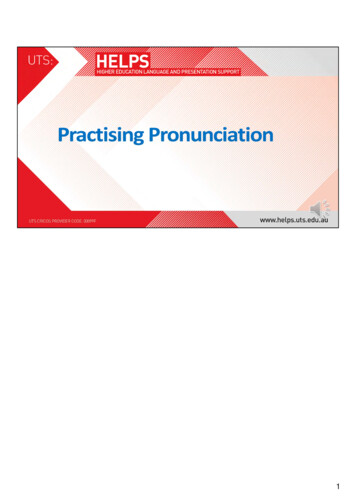
Transcription
1
2
Everybody has an accent, whether English is your first language or not. (e.g. Australianaccent, Received pronunciation (British) accent, Scottish accent, Canadian accent,General American, New York accent, Korean accent, Indian accent, French accent etc).Kofi Annan and Ban Ki Moon are examples of English speakers who have intelligiblepronunciation but don’t have a General American accent or British receivedPronunciation accent.Good pronunciation is usually judged by intelligibility, not by sounding like a BBC newsreader or some other such benchmark. Pronunciation involves more than just howindividual words are said – for example, where the pauses are, how the voice rises orfalls, which words are stressed to convey meaning etc. and these features will bepractised in this workshop series.There are so many things people can do to improve their pronunciation (e.g. using asystem of notation for sounds, stress, pauses etc., asking friends for feedback, recordingyourself, practising sounds using a mirror, learning a phonetic script, singing songs inEnglish, reading aloud, watching TV shows or talks and trying to parallel speak with thespeaker etc etc)3
4
5
The transcription reads: “Do you know how to read phonetic symbols”? Thetranscription also includes the weak forms for “do” and “to”.Using phonemic script is not essential but it can be helpful when keeping a record ofwords you have difficulty pronouncing.E.g. If you are giving a presentation and there are a few key words that must bepronounced properly (so that your audience understands you), you can use thephonemic script to keep a record of the way these words are pronounced and thenpractise these words. You can also record and listen to yourself on your phone or asksomeone else to listen to you saying these words.6
The words in these groups are minimally different due to a different CONSONANT sound.Depending on one’s first language, it may be difficult to clearly differentiate betweensome of them.7
The words in these groups are minimally different due to a different VOWEL sound.Depending on one’s first language, it may be difficult to clearly differentiate betweensome of them.Although English has only 5 written vowels, there are at least 20 spoken vowelsincluding short vowel sounds, long vowel sounds and diphthongs. Many languages havefewer vowel sounds than English and so speakers of English as a second language maytry to cover all the English vowel sounds with a much smaller repertoire of sounds.8
English spelling and pronunciation has been shaped by so many languages and eventsthroughout history. There is not the one‐to‐one relationship between spelling andpronunciation as there is in other languages (e.g. Italian, Turkish)9
Stressing the right syllable in a long word can make the difference in being understoodor not. Many academic words are multisyllabic.It is a good idea to:‐ write down any words you are having difficulty with(especially key vocabulary for presentations),‐ break the word up into syllables, and practise saying eachsyllable separately (with the correct vowel and consonant sounds)‐ make note of the stress pattern in that word, and practisesaying the word with the correct syllable stressedNote that in many words, when suffixes are used to make different parts of speech(verb/noun/adjective/adverb) , a different syllable is stressed (e.g politics, politician,political)There are many words that have the same form/spelling for both a noun and a verb (e.gproduce, refuse, object, record, import). However, when used as a noun the first syllableis stressed and when used as a verb the second syllable is stressed.Students should devise their own way of notating stress (eg. underline the stressedsyllable, capitalise the stressed syllable, a mark over the stressed syllable etc.)10
Stressing key words in sentences helps to communicate meaning and is therefore veryimportant. When giving a presentation it is vital to highlight information by stressing keywords.Stressed syllables are longer and louder than unstressed syllables. This contrast is howthe English language works.The speaker uses the most stress for the words that they consider to be most important.Stressed syllables in key/ focus words also carry some change in pitch.11
In this recording, the speaker has stressed all, giving, presentations, week 8, start,research, this week.The focus words with the most stress are eight , start and this12
13
I think you’re RIGHTGeneral agreementI think YOU’RE rightI agree with you, but not with other peopleI THINK you’re rightI agree, but I still have doubtsI think you’re rightI agree with you even if others don’t.14
When speakers use meaningful pauses and divide their speech into “chunks”, they are‘packaging’ the information for listeners.A chunk can be a single word, a phrase or a whole sentence.In each chunk the most important word is given the most emphasis/ stress. Pitch changeoccurs on this word (tonic stress).Pauses are particularly important when giving presentations in order to break upinformation into sizable chunks. When you want to signal a new topic, a long pause isnecessary (along with words and phrases that signal a transition and non‐verbal cuessuch as hand gestures or shifting position)15
In this recording the speaker uses no pauses or chunking. It is difficult to understand.16
In this recording the speaker uses pauses and chunking. However, the pauses areINAPPROPRIATELY placed. Therefore, it is difficult to understand.17
In this recording the speaker has used pauses and chunking meaningfully. It is mucheasier to understand.When speakers use meaningful pauses and divide their speech into “chunks”, they are‘packaging’ the information for listeners.A chunk can be a single word, a phrase or a whole sentence.In each chunk the most important word is given the most emphasis/ stress. Pitch changeoccurs on this wordPauses are particularly important when giving presentations in order to break upinformation into sizable chunks. When you want to signal a new topic, a long pause isnecessary (along with words and phrases that signal a transition and non‐verbal cuessuch as hand gestures or shifting position)18
19
Intonation is the rise and fall of the voice.In very general terms, the voice falls at the end of sentences and WH questions. It risesat the end of yes/no questions.20
Intonation is the rise and fall of the voice. As well as grammatical meaning (sentences,wh questions, yes/no questions), intonation serves other communicative purposes.1) with a falling intonation in “It’s an interesting subject, isn’t it?”, the speaker is simplystating that it is an interesting subject and seeking the listener’s agreement.2) with a rising intonation in “It’s an interesting subject, isn’t it?”, the speaker is unsureabout whether it’s an interesting subject and asking the listener for informationabout whether or not it is interesting – more of a “genuine” question.21
22
Intonation is the rise and fall of the voice. As well as grammatical meaning (sentences,wh questions, yes/no questions), intonation serves other communicative purposes.1) giving information confidently – a statement2) question or not sure3) incomplete statement – you have something more to say4) you have some doubts/ reservations5) Emphasising – enthusiastic, happy, surprised or contrasting what someone else said23
24
In connected speech, words are often linked together and weak forms are used.Combined with stressing key words, this is what gives English its rhythm.While it not essential that students use a lot of linking and weak forms in the productionof language (ie. speaking), it is very useful for students to learn about these features inorder to aid their comprehension of oral language (ie. listening)25
1. The use of schwa is a feature of weak forms.The kinds of words that often (not always) are pronounced in their weak form are:articles, prepositions, pronouns, conjunctions, auxiliary verbs, modals2.o a Masters in Business Administration ‐ has 2 examples of consonant to vowel linkingbetween words.The /z/ sound at the end of “masters”could be linked to the initial a in “administration”, the /s/ sound at the end of “business”could be linked to the initial ‘a’ sound in “administraion”o I’d like to be an accountant – K in “like” is often elided with t in “to”, between “be”and “an” a linking /j/ sound is often used, the n in “an” could be linked to the initial ‘a’in “accountant”o She’s in first year ‐ The /z/ sound at the end of “she’s” could be linked to the initial Isound in “in”, the ‘t’ sound at the end of “first” and the initial /j/ sound in ‘year’ can belinked and a new sound “ch” could be used26
Pace or speed ‐ Speak at just the right speed, not too fast, not too slow. When you aregiving a presentation, it's a good idea to vary your speed. This is something we donaturally depending on what we are talking about and how we feel about it. It's part ofwhat gives speech vitality and interest.Volume‐ Speaking too loud or too softly can be irritating to your listener and get in theway of communicating your ideas effectively. Judge the right volume for your situation.Take care when giving a presentation. The person sitting at the back of the room shouldbe able to hear you without straining.Pitch level‐ Varying your pitch level (that is, how high or low your voice is) can be aneffective way of signalling a new topic when giving a presentation. In general, we jumpup to a higher pitch level to signal something new or to signal that we are presentingimportant or major information. We tend to move to a lower pitch to indicate minor oradditional information.When giving a presentation, you do not want to speak in a monotone as you want tokeep your audience’s attention. Along with appropriate pausing and key word stress, it isimportant to vary pace, volume and pitch somewhat.Voice quality ‐ This term is hard to define, but we all instinctively know what it means inany language. Basically, it refers to the 'sound' of a person's voice, for example, 'smooth','harsh', 'abrupt', 'warm', 'cold' or 'tense'. Some people refer to it as 'tone of voice'. Weare all sensitive to voice quality. For example, we can often guess how someone is27
feeling when we speak to them on the phone, even if they only say the single word'hello'. There may be something in that person's voice quality that makes you ask, 'What'swrong?' Your listeners are more likely to share your interest in what you are saying if yourvoice expresses your own interest.27
It is important that language learners reflect on their own areas of weakness in order toimprove them.28
L1 interference can cause pronunciation difficulties. As a result students from differentlanguage backgrounds will need to work on aspects of their pronunciation.NEXT SLIDE: A useful reference for students is the first part in each chapter of: Swan, M.& Smith, B. (eds) 2008 Learner English: A teacher’s guide to interference and otherproblems, Cambridge University Press, Cambridge. Each chapter deals with a differentlanguage but not all languages are covered.It is important that language learners can identify and reflect on their own areas ofweakness in order to improve them.29
L1 interference can cause pronunciation difficulties. As a result students from differentlanguage backgrounds will need to work on aspects of their pronunciation.A useful reference for students is the first part in each chapter of: Swan, M. & Smith, B.(eds) 2008 Learner English: A teacher’s guide to interference and other problems,Cambridge University Press, Cambridge. Each chapter deals with a different language butnot all languages are covered.It is important that language learners can identify and reflect on their own areas ofweakness in order to improve them.30
31
32
33
General American, New York accent, Korean accent, Indian accent, French accent etc). Kofi Annan and Ban Ki Moon are examples of English speakers who have intelligible pronunciation but don’t have a General American accent o
